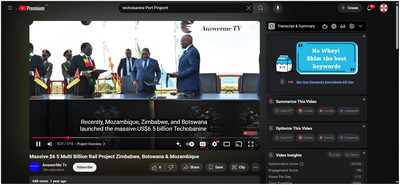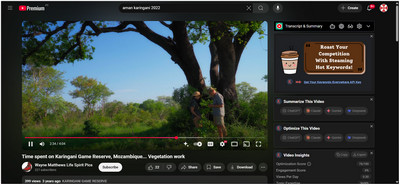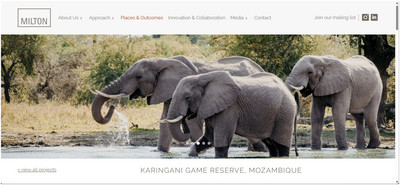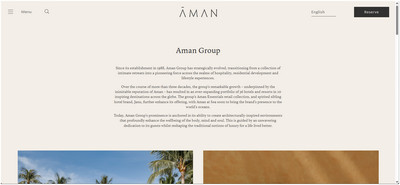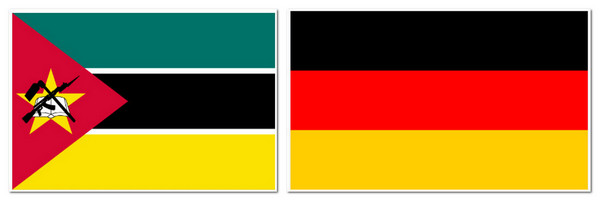
Investor Insight Newsletter
NEWS
Edition 1 | September 18, 2025
Unlocking Opportunities in Mozambique's Evolving Market
Maputo, Mozambique – Russian automotive giant Kamaz is eyeing an assembly plant in Mozambique, as announced by newly appointed Russian Ambassador Vladimir Nikolaevich Tararov during his credentials presentation to President Daniel Chapo on September 15, 2025. This initiative, aimed at bolstering bilateral ties and economic growth, could mark a significant entry for Russian manufacturing FDI in southern Africa. For foreign investors, it highlights Mozambique's diversification push beyond gas, offering potential supply chain synergies in logistics and automotive sectors, though timelines and funding details remain unclear.
Background: Russia-Mozambique Relations and Kamaz's Global Footprint
Diplomatic ties between Russia (and its Soviet predecessor) and Mozambique date back to Mozambique's independence in 1975, rooted in Cold War-era support for liberation movements against Portuguese colonialism. The Soviet Union provided military training, equipment, and technical aid, establishing a foundation of "reliable and time-tested" partnership. Post-1991, relations evolved into economic cooperation, with Russia marking the 50th anniversary of diplomatic ties in June 2025 through high-level talks between Foreign Ministers Sergey Lavrov and Maria dos Santos Lucas. Bilateral trade reached ~$109 million in 2021 (latest detailed figure), focusing on energy, agriculture, and mining, though it remains below potential amid Western sanctions on Russia. In 2025, discussions emphasized geological exploration, telecommunications, and diversification, with Russia inviting Mozambican firms to the St. Petersburg Forum. Mozambique's neutral stance on the Ukraine conflict has preserved ties, allowing Russia to expand influence in Africa via BRICS and bilateral deals.
Kamaz (Kamskiy Avtomobilnyy Zavod), founded in 1969 in Russia's Tatarstan Republic, is the world's 16th-largest heavy truck producer and Russia's largest, manufacturing over 53,000 vehicles annually. Known for rugged cab-over trucks (14-40 ton GVW), it exports to 80+ countries, including Africa, and has won the Dakar Rally 18 times. Kamaz has prior African ventures: a €50 million assembly plant in Senegal (planned 2017, operational by 2024-2025) and partnerships in South Africa (2017 via Bell Equipment for tipper trucks). In Mozambique, Kamaz trucks have been imported for years, praised for robustness in mining, agriculture, and logistics—e.g., in harsh terrains like Gaza and Cabo Delgado. No prior assembly exists, but positive experiences (e.g., durability in construction) pave the way for local production.
Ambassador Tararov, appointed August 18, 2025 (Decree No. 569), succeeds previous envoys and brings experience from Angola (2017-2025). His presentation to President Chapo (inaugurated January 2025) underscores Russia's pivot to Africa amid sanctions, seeking new markets for Kamaz (state-owned via Rostec 49.9%).
Foreign Minister Maria dos Santos Lucas, speaking for Chapo, welcomed the proposal, noting job creation potential (direct/indirect via services) and alignment with Mozambique's industrialization goals under the Five-Year Plan (2025-2029). No launch date was specified, but it fits broader diversification from gas (Rovuma Basin) to manufacturing.
Implications for Foreign Investors
This Kamaz venture could inject $50-100 million (based on similar African plants), creating 500+ jobs and boosting automotive supply chains—key for Mozambique's mining (coal, rubies) and agriculture (cashews, prawns). It enhances mobility in corridors like Nacala, reducing import reliance (trucks from China/South Africa dominate). For FDI, opportunities include joint ventures in parts supply, EV tech (Kamaz's Hungarian electric plans by 2025), or logistics hubs. Russia's BRICS ties could facilitate financing via Eurasian Bank, amid Mozambique's $300 billion investment needs.
Risks: Sanctions limit Kamaz exports/tech transfers; Mozambique's forex shortages (3.2 months reserves) and bureaucracy (138th Ease of Doing Business) delay setups. Geopolitical tensions (Ukraine) may deter Western partners, but neutral Mozambique benefits from diversified FDI.
Techobanine Port Project Needs 20 Million Tons Annual Traffic for Viability – Regional Partners Sought
Maputo, Mozambique – The ambitious Techobanine deep-water port project in Matutuíne district, Maputo Province, requires at least 20 million metric tons (MMT) of annual cargo traffic to justify construction, according to Ports and Railways of Mozambique (CFM) Chairman Agostinho Langa in a September 15, 2025, interview with Notícias. Currently stalled due to insufficient committed volumes from core partners Mozambique, Botswana, and Zimbabwe, the initiative is seeking involvement from South Africa and Eswatini to reach viability thresholds. For foreign investors, this highlights potential in regional infrastructure FDI, with AfDB funding advancing feasibility studies amid a $6.5 billion total cost.
Background: A Long-Gestating Regional Trade Hub
The Techobanine project, first conceptualized in the early 2000s, aims to create a deep-water port at Ponta Techobanine (70 km south of Maputo) and a 1,700 km railway corridor linking Botswana's coal fields through Zimbabwe to Mozambique's coast. Estimated at $6.5 billion overall (with rail at $600 million split among partners), it would feature a 20-meter-deep harbor for Capesize vessels, fuel terminals, gas pipelines, and storage, easing congestion at South Africa's Durban and Richards Bay ports. The port, spanning 13,000 hectares, targets minerals (coal from Botswana's 212 billion tons reserves), agriculture, and general cargo, boosting SADC trade.
Historical Timeline:
2010-2011: Initial tripartite agreement signed by Presidents Armando Guebuza (Mozambique), Ian Khama (Botswana), and Robert Mugabe (Zimbabwe) for feasibility studies.
2016-2020: Delays due to funding shortages and competing routes (e.g., Trans-Kalahari to Namibia). Botswana prioritized South Africa via a $300 million link to Richards Bay.
2022-2024: Relaunched under Presidents Filipe Nyusi, Mokgweetsi Masisi, and Emmerson Mnangagwa. Tripartite summits in Maputo (July 2024) signed draft rail agreements; $10 million injected for Limpopo Railway upgrades (Chicualacuala to Maputo). AfDB granted $3-4 million for integrated feasibility studies in February 2025, focusing on profitability and environmental impact.
2025 Status: No construction underway; studies ongoing. Langa's comments (April 15, 2025, report) emphasize cargo shortfalls—Botswana/Zimbabwe/Mozambique combined volumes fall below 20 MMT threshold for Capesize viability. Inclusion of South Africa (for chrome/coal) and Eswatini (sugar/textiles) is proposed to hit targets.
The project integrates with SADC's trade goals, potentially handling 50-100 MMT/year long-term, but faces environmental scrutiny: August 2025 conservationists warned of damage to coral reefs and marine life in a UNESCO-proposed World Heritage site (Maputo Special Reserve). Mozambique committed to no development within protected zones, but feasibility must address impacts.
CFM, state-owned operator of Mozambique's 3,485 km rail network (only 20% electrified), leads implementation alongside Botswana Railways and National Railways of Zimbabwe. Chairman Langa, appointed 2023, oversees expansions like Maputo Port upgrades amid 4-5% GDP growth.
Current Challenges and Path Forward
Langa confirmed no activity on-site, with AfDB studies (2025) assessing cargo guarantees, environmental viability, and financing. Initial phase: Fuel terminal for regional supply. Full rollout depends on tripartite synergy and South African/Eswatini buy-in, potentially by 2027-2030 if studies succeed. Aligns with ENDE 2025-2044 for $300 billion infrastructure push, but critics cite redundancy with Maputo Port (capacity 20 MMT/year, expandable).
President Chapo Inaugurates $140 Million Tourism Project in Gaza's Massingir – A Milestone for Sustainable FDI
Maputo, Mozambique – On September 17, 2025, President Daniel Chapo inaugurated a landmark $140 million tourism development in Massingir district, Gaza Province, signaling Mozambique's growing appeal as a sustainable investment destination. Led by Swiss-headquartered Aman Group in partnership with Karingani Holding Company and Impact Preservation Partners, the project promises high-end eco-luxury accommodations, 400 direct jobs, and biodiversity conservation. For foreign investors, this initiative highlights opportunities in Africa's burgeoning green tourism sector, though infrastructure and regulatory hurdles persist.
Background: Gaza Province and Massingir's Untapped Potential
Gaza Province, in southern Mozambique, spans 75,709 km² with a population of about 1.4 million (2017 census, estimated 1.5 million in 2020). Bordering South Africa and Zimbabwe, it features diverse ecosystems including the Limpopo River basin, savannas, and proximity to the Indian Ocean, making it ideal for eco-tourism. The province's economy relies on agriculture (e.g., citrus exports), subsistence fishing, and emerging tourism, contributing to national GDP through wildlife and cultural assets. However, challenges like poverty (46% rate), climate vulnerability (e.g., 2024 Cyclone Freddy displaced 140,000+), and underdevelopment limit growth—tourism accounts for just 7-8% of GDP nationally, with Gaza's share minimal.
Massingir District, Gaza's western outpost, borders Limpopo National Park (part of the 35,000 km² Great Limpopo Transfrontier Park with South Africa's Kruger and Zimbabwe's Gonarezhou). This 2,100 km² area hosts the Massingir Dam (a key irrigation and crocodile breeding site) and the 150,000-hectare Karingani Game Reserve, home to "Big Five" wildlife (elephants, lions, leopards, rhinos, buffaloes). Established in 2013 as a private conservation effort, Karingani combats poaching (e.g., rhino horn trade) and promotes community-led eco-tourism, aligning with Mozambique's National Tourism Master Plan (2023-2033) for sustainable growth. The district's airfield, currently a basic strip, supports charters but lacks international capacity—upgrades are crucial for accessibility.
Mozambique's tourism sector rebounded post-COVID, attracting $200 million FDI in 2024, but Gaza lags behind coastal hotspots like Inhambane. Projects like this address diversification needs amid gas dependency (Rovuma Basin).
Project Details: Luxury Meets Conservation
The initiative, Aman Karingani, will develop a 5-star safari resort within Karingani Game Reserve, featuring pavilions, residences, a spa, and immersive wildlife experiences. Budgeted at $140 million, it includes:
International-Standard Hotel: 30-50 rooms/villas blending luxury with eco-design, opening in 2028.
Job Creation: 350 construction jobs (2025-2028) and 400 permanent roles, prioritizing local youth and women; includes training in hospitality and wildlife tracking (e.g., 23 scholarships in Cape Town).
Conservation Focus: Enhances biodiversity in the reserve (elephants, big cats), linking tourism to anti-poaching and community revenue-sharing.
Partners:
Aman Group: Swiss-based luxury hospitality leader (founded 1988), operating 36 properties in 20 countries with a $3 billion valuation (2023). Known for intimate retreats (e.g., Amanpuri, Thailand), Aman enters Africa via this project, emphasizing privacy and sustainability.
Karingani Holding Company: Mozambican entity managing the 150,000-ha reserve since 2013; focuses on private conservation and eco-tourism, with prior $7 million investments in infrastructure.
Impact Preservation Partners: Likely a conservation-focused firm (limited public data; possibly tied to impact investing in eco-tourism), emphasizing sustainable models that balance profit and heritage preservation.
President Chapo hailed it as a "historic milestone," boosting investor confidence in Gaza's environmental assets. He announced Massingir Airfield upgrades to handle Boeing-sized aircraft in 10-20 years, serving as a tourism gateway and export hub for Gaza/Inhambane agriculture/livestock—aligning with the Five-Year Plan (2025-2029) for 7-10% growth and $300 billion investments.
Karingani CEO Paul Milton noted years of persistence, promising lasting community impact through training and economic uplift.
Implications for Foreign Investors
This project exemplifies Mozambique's tourism pivot: from 7% GDP contribution (pre-COVID) to a projected 10% by 2030 via eco-luxury. Gaza's savanna-beach combo (linking to Vilanculos/Tofo) offers untapped potential, with incentives like tax holidays (5-10 years) for sustainable tourism under APIEX. FDI could surge via PPPs for airfield/infrastructure ($10 billion targeted nationally). Aman's entry validates Mozambique, potentially attracting $500 million more in hospitality FDI.
Maputo, Mozambique – In a significant development for Mozambique's energy sector, India's state-run Oil India Ltd (OIL) announced today, September 18, 2025, at its annual shareholder meeting, that the $20 billion Mozambique LNG project—operated by TotalEnergies and including an OIL stake— is poised to resume development by year-end. This follows a four-year hiatus due to security concerns, with improved conditions in Cabo Delgado province sparking renewed optimism. For foreign investors, this signals a potential resurgence of FDI in Mozambique's gas-rich north, though risks remain.
Background: A Project on the Brink of Revival
The Mozambique LNG project, located in the Rovuma Basin off Cabo Delgado, targets 12.88 trillion cubic feet (tcf) of natural gas reserves, aiming to produce 13 million tonnes per annum (mtpa) of liquefied natural gas (LNG), with potential expansion to 26 mtpa. Launched with a final investment decision (FID) in 2019, it was set to position Mozambique as Africa's fourth-largest LNG exporter by 2025, contributing up to 25% of GDP and generating over $100 billion in revenue over 25 years. The project features an onshore facility at Afungi peninsula with two liquefaction trains, a gas processing plant, and export infrastructure, targeting markets in Asia and Europe.
Construction halted in March 2021 after Islamic State-linked insurgents attacked Palma town near the site, killing 55 and displacing 800,000+ residents. TotalEnergies declared force majeure, evacuating 1,500 workers amid escalating violence that began in 2017 with local militants (Ansar al-Sunna) pledging allegiance to ISIS. The insurgency, driven by poverty and resource curse grievances, has killed 4,000+ and displaced 1 million, though security has improved with Rwandan (1,000 troops) and SADC (2,000+) forces since 2021. Attacks dropped 70% by 2023 but spiked in 2025 (e.g., 57,000 displaced in July-August), though Afungi remains relatively secure. Cyclone Chido (December 2024) added climate risks, displacing 50,000+.
Stakeholders:
TotalEnergies (26.5%): Operator with LNG expertise.
Mitsui & Co (20%): Japanese financing and offtake.
ENH (15%): Mozambican state entity ensuring local content.
Indian Consortium (30%): ONGC Videsh, Bharat PetroResources, and Oil India (~10% each) target India's 15% gas import goal by 2030.
PTTEP (8.5%): Thai firm for Southeast Asian markets.
Oil India's confidence stems from $942 million in dividends (91% of its $1 billion Russian investments) from Vankorneft and Taas-Yuryakh, bolstering its Mozambique exposure. TotalEnergies' CEO Patrick Pouyanné's June 2025 "this summer" forecast, delayed to H2 due to monsoons, aligns with OIL's timeline.
The Restart: Security and Economic Drivers
Improved security, with Rwandan patrols and community programs reducing attacks by 80% near Afungi, underpins the restart. Mozambique lifted force majeure in July 2025 after President Chapo's talks with Pouyanné, with FID re-approval expected by Q4. The IMF's $456 million Extended Credit Facility (2025) ties aid to gas revival, mandating 30% local jobs. First gas, delayed from 2024 to 2029+, could add 1-2% to Mozambique's 4-5% GDP growth in 2026.
Maputo, Mozambique – In a boost for foreign investors, Mozambique and Germany are deepening their partnership, emphasizing digital transformation as a key driver of economic growth. During a networking session at the 60th Maputo International Trade Fair (FACIM) in August 2025, a German business delegation highlighted Mozambique's strategic potential, signaling opportunities for collaboration in high-tech and sustainable sectors.
Highlighting Mozambique's Appeal
The German Embassy in Mozambique hosted the event to showcase a delegation of business leaders attending FACIM, Africa's largest trade fair. Participants praised Mozambique's geographic advantages as a Southern African gateway, its growing macroeconomic stability, and ongoing reforms to enhance the business climate. With a projected 4-5% GDP growth in 2025, driven by gas projects and diversification, these factors position the country as an attractive hub for European FDI. Bilateral trade exceeded $160 million in 2024, while German investments totaled around $90 million, primarily in renewables, agroindustry, digitalization, and engineering.
German Ambassador Ronald Münch commended the "excellent bilateral relations," noting Germany's role as a reference partner since diplomatic ties were established in 1976. He emphasized mutual benefits in technology transfer and sustainable development, aligning with Mozambique's National Digital Development Strategy.
Key Voices on Collaboration
Mozambique's Minister of Communications and Digital Transformation, Américo Muchanga, reaffirmed the country's eagerness to bolster ties, particularly by leveraging German expertise to tackle structural challenges in agriculture, industrialization, and energy transition. Muchanga, appointed in May 2025 under President Daniel Chapo, highlighted initiatives like digital identity systems, cybersecurity laws, and AI strategies as priorities for the 2025-2029 Five-Year Plan.
Amâncio Gume, Vice-President of the Confederation of Economic Associations (CTA), welcomed representatives from Germany's Chamber of Commerce and Industry Abroad (AHK), underscoring strengthened institutional links between private sectors. This connection facilitates market access, joint ventures, and knowledge sharing, fostering inclusive growth.
Implications for Investors
For foreign investors, this partnership signals a maturing ecosystem ripe for digital innovation. Germany's focus on renewables (e.g., GET FiT program via KfW) and agroindustry aligns with Mozambique's $80 billion energy transition strategy, offering entry points in solar, wind, and green hydrogen. Digitalization reforms, supported by EU and German funding, promise streamlined operations and reduced bureaucracy, with blockchain for procurement and expanded connectivity targeting 50% digital public services by 2029. Challenges like forex shortages persist, but bilateral commitments could mitigate risks through co-financed projects.
Action Steps: Connect with AHK Mozambique (www.ahk-mozambique.com) for business matchmaking and APIEX (www.apiex.gov.mz) for incentives. Monitor the XX CASP Conference (November 12-14, 2025) for policy updates on digital and energy reforms.
Maputo, Mozambique – As Mozambique accelerates its digital transformation in September 2025, reforms targeting bureaucratic red tape and corruption are poised to streamline operations for foreign investors. Aligned with the Five-Year Plan (2025-2029), these initiatives promise efficiency gains but face hurdles like connectivity gaps—essential reading for those eyeing long-term commitments.
The Current Landscape: Paper-Based Hurdles and Corruption Risks
Mozambique's public services are still largely paper-based and fragmented, with business registration at the One-Stop Shop (BAU) taking 17-30 days—a process that fosters corruption, as evidenced by the country's 2024 Corruption Perceptions Index score of 26/100. This inefficiency delays FDI approvals, licensing, and tax compliance, adding hidden costs and risks for investors in sectors like energy and agriculture. Customs and visa procedures often involve manual checks, amplifying delays and opportunities for informal payments, which can erode up to 10-15% of project budgets.
Implications for Investors
For foreign firms, these bottlenecks mean prolonged setup times and heightened exposure to graft, complicating compliance in a market ranked 138th in the World Bank's Ease of Doing Business (pre-2020 baseline, with persistent issues). SMEs and startups face the brunt, but larger investors in mining or renewables risk project overruns. Low digital readiness—only 30% internet penetration—exacerbates skills shortages, making it tough to integrate tech solutions without local capacity building.
Emerging Solutions and Opportunities
The 2025 Digital Transformation Strategy, spearheaded by the Ministry of Science and Technology, is driving change by digitizing licenses, visas, and taxes through platforms like e-BAU and the National Digital ID system. June 2025 government statements projected that this shift could slash corruption via reduced human intervention and cut management costs by 20-30%. Backed by the World Bank's $100 million Digital Governance and Economy Project (2023-2028), the plan targets 50% digital public services by 2029, incorporating blockchain for transparent procurement to curb graft. A July 2025 UNECA workshop boosted data governance, while FACIM 2025 seminars spotlighted electronic payments and data sharing to fast-track FDI approvals. These reforms open avenues for tech-savvy investors to partner in digital infrastructure, qualifying for incentives like tax holidays in priority sectors.
Maputo, Mozambique – As of September 2025, Mozambique's foreign exchange (forex) landscape poses significant challenges for foreign investors, with shortages threatening import-dependent industries and driving economic instability. With the country aiming for 7-10% GDP growth under its Five-Year Plan (2025-2029), addressing these pressures is vital to sustaining investor confidence. Here's what you need to know.
The Current Crisis: Shrinking Reserves and Rising Costs
Forex shortages have intensified in 2025, with net international reserves covering just 3.2 months of imports (excluding megaprojects), down from 4.5 months in 2024. The Bank of Mozambique (BOM) has maintained a fixed exchange rate of approximately 64 MZN/USD since 2023, resulting in a parallel market premium of 20-30%. This gap fuels currency hoarding and speculation, undermining business planning. The scarcity, worsened by reduced donor aid—such as the USAID suspension in 2025—and stalled gas exports, severely restricts imports of critical inputs like fuel and machinery. This has pushed inflation to 8-10%, with production costs rising 15-20%, hitting sectors like manufacturing and agriculture hard.
Interbank forex transactions plummeted 67% to $44 million in 2024, a trend persisting into 2025, particularly affecting small and medium enterprises (SMEs) reliant on imports from key partners like South Africa (25% of total) and China (14%). Despite government denials of systemic shortages, BOM's July 2025 restrictions—capping individual forex access at $10,000 per month—risk exacerbating the crisis. Fitch Ratings upheld Mozambique's 'CCC' sovereign rating in August 2025, flagging forex pressures as a major risk amid a public debt exceeding 100% of GDP.
Implications for Investors
For foreign investors, this forex crunch translates to higher operational costs and supply chain disruptions, especially in import-heavy industries. Fuel shortages, evident in a 2025 crisis in Beira and Pemba, have led to black market activity, while machinery delays hinder project timelines—key concerns for mining and agro-processing ventures. SMEs, a backbone of the economy employing 80% of the workforce, face credit squeezes, potentially deterring joint ventures. The parallel market premium also complicates repatriation of profits, adding financial risk.
Emerging Solutions and Opportunities
The government, supported by the IMF's $456 million Extended Credit Facility (2025-2029), is exploring forex stabilization measures, including currency market liberalization and boosting export revenues from gas projects like Coral Norte (set for FID in late 2025). Efforts to diversify the economy—targeting agriculture, tourism, and renewables—aim to reduce import dependency. For investors, this opens doors to strategic partnerships in forex-resilient sectors or financing infrastructure to support local production, potentially qualifying for tax incentives.
Maputo, Mozambique – Mozambique's infrastructure and logistics landscape presents both hurdles and opportunities for foreign investors as of September 2025. With the country targeting a 7-10% GDP growth under its National Development Strategy (ENDE 2025-2044), addressing these challenges is critical to unlocking its vast potential in agriculture, mining, and trade. Here's the latest on the ground.
The Current Landscape: Costly Bottlenecks
Mozambique's infrastructure lags behind regional peers, with the World Bank estimating that poor roads, ports, and rail networks drive logistics costs to a staggering 20-30% of goods value—among the highest in Africa. This steep expense hampers foreign direct investment (FDI) and export competitiveness, particularly for industries reliant on timely supply chains. At key ports like Maputo and Beira, complex customs procedures—marked by multiple inspections and delays—add 10-15 days to import timelines, a burden exacerbated by bureaucratic inefficiencies and corruption.
Urban congestion in Maputo, fueled by rapid population growth (now exceeding 1.2 million), further compounds the issue. Inadequate public transport systems cost the economy an estimated $500 million annually in lost productivity, choking commerce and mobility. The northern insurgency and recent climate events, including the devastating 2025 floods, have worsened the situation, degrading critical corridors like the Nacala line and displacing supply chains. These factors contribute to Mozambique's ranking of 138th in the World Bank's Ease of Doing Business index (pre-2020 baseline, with similar challenges persisting), a red flag for foreign firms in agriculture and mining.
Opportunities Through Public-Private Partnerships (PPPs)
A promising avenue for improvement lies in Public-Private Partnerships (PPPs), building on the 2011 PPP Law that delivered successes like the Maputo-KaTembe Bridge (completed 2018). This framework has yet to reach its full potential due to regulatory hurdles, but 2025 marks a turning point. The government has launched PPP tenders for urban rail in Maputo and road upgrades under the ENDE 2025-2044, targeting a hefty $10 billion in investments. These initiatives aim to modernize transport networks and enhance trade corridors, offering foreign investors a chance to partner in high-impact projects.
The Nacala Logistics Corridor, linking the port to Malawi and Zambia, is a prime example of potential, with ongoing upgrades supported by the African Development Bank (AfDB). However, political risks—stemming from post-election instability and governance concerns—continue to deter some investors. For those willing to navigate these waters, opportunities abound in co-financing infrastructure that could yield long-term returns, especially in agro-processing and mineral exports.
What This Means for You
For foreign investors, these challenges signal caution but also strategic entry points. High logistics costs erode profit margins, while customs delays and congestion disrupt operations—key considerations for sectors like mining (e.g., coal from Tete) and agriculture (e.g., cashew exports). The PPP push, however, opens doors for joint ventures, particularly in urban mobility and port modernization, with potential tax incentives under the 2025-2029 Five-Year Plan.

